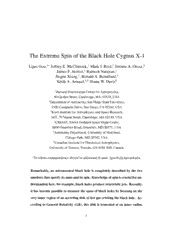
NASA Technical Reports Server (NTRS) 20110008045: The Extreme Spin of the Black Hole Cygnus X-1 PDF
Preview NASA Technical Reports Server (NTRS) 20110008045: The Extreme Spin of the Black Hole Cygnus X-1
The Extreme Spin of the Black Hole Cygnus X-1 Lijun Gou,'* Jeffrey E. McClintock,' Mark J. Reid,' Jerome A. Orosz,2 James F. Steiner,' Ramesh Narayan,' Jingen Xiang,', Ronald A. Remillard,3 4,1 Keith A. Arnaud, Shane W. Davis' 'Harvard-Smithsonian Center for Astrophysics, 60 Garden Street, Cambridge, MA, 02138, USA 2Department of Astronomy, San Diego State University, 5500 Campanile Drive, San Diego, CA 92182, USA 'Kavli Institute for Astrophysics and Space Research, MIT, 70 Vassar Street, Cambridge, MA 02139, USA 4CRESST, NASA Goddard Space Flight Center, 8800 Greenbelt Road, Greenbelt, MD 20771, USA 'Astronomy Department, University of Maryland, College Park, MD 20742, USA 'Canadian Institute for Theoretical Astrophysics, University of Toronto, Toronto, ON M5S 3148, Canada *To whom correspondence should be addressed; E-mail: [email protected]. Remarkably, an astronomical black hole is completely described by the two numbers that specify its mass and its spin. Knowledge of spin is crucial for un- derstanding how, for example, black holes produce relativistic jets. Recently, it has become possible to measure the spins of black holes by focusing on the very inner region of an accreting disk of hot gas orbiting the black hole. Ac- cording to General Relativity (GR), this disk is truncated at an inner radius 1 that depends only on the mass and spin of the black hole. We measure the ra- dius of the inner edge of this disk by fitting its continuum X-ray spectrum to a fully relativistic model. Using our measurement of this radius, we deduce that the spin of Cygnus X-1 exceeds 97% of the maximum value allowed by GR.
